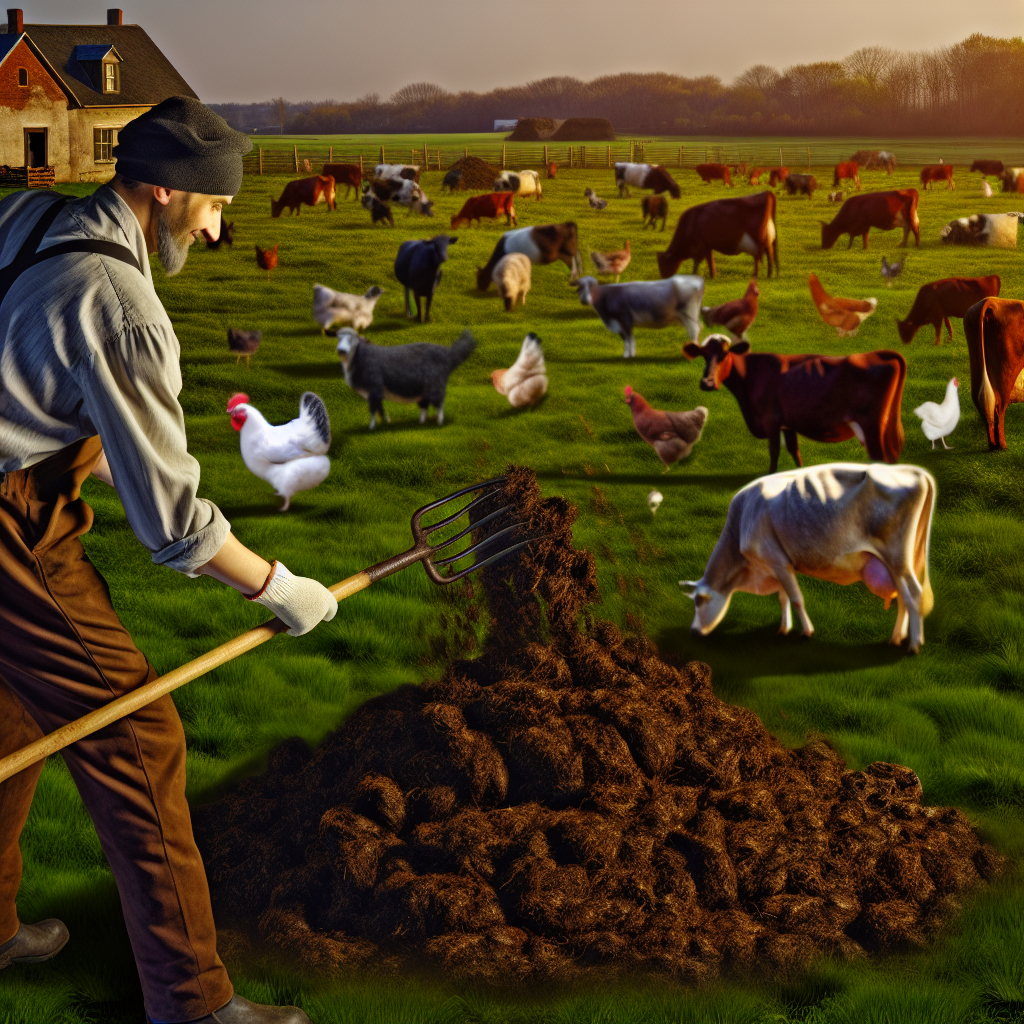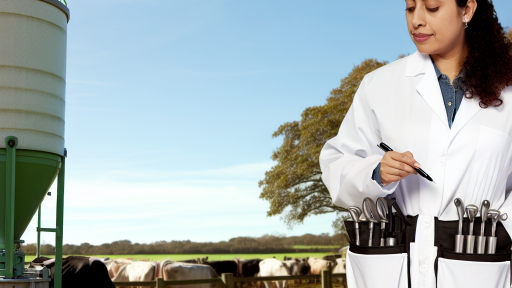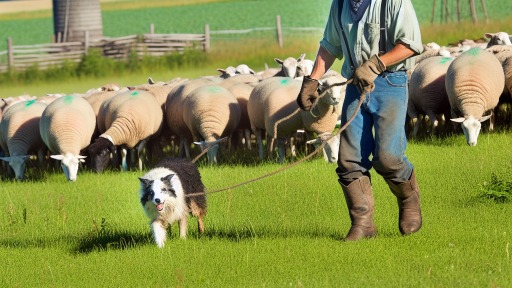Introduction to Livestock Manure
Definition and Importance
Livestock manure refers to the waste produced by animals raised for food, fiber, and labor.
This waste plays a vital role in agriculture and sustainable farming practices.
Understanding its benefits and proper management can enhance soil health significantly.
Manure is rich in nutrients such as nitrogen, phosphorus, and potassium.
These nutrients are essential for plant growth and overall soil fertility.
Moreover, manure helps improve soil structure, water retention, and microbial activity.
It also serves as a natural fertilizer, reducing the need for chemical alternatives.
However, managing livestock manure effectively is crucial to minimize environmental impacts.
Improper handling can lead to nutrient runoff and contamination of water sources.
Furthermore, it can contribute to greenhouse gas emissions, affecting climate change.
Therefore, farmers must adopt best practices for manure management.
Such practices include timely application, proper storage, and efficient utilization strategies.
By doing so, they can maximize the benefits of manure while protecting the environment.
Ultimately, responsible manure management fosters healthy ecosystems and productive agricultural systems.
Types of Livestock Manure and Their Nutrient Content
Overview of Livestock Manure
Livestock manure comes from various animal sources.
Transform Your Agribusiness
Unlock your farm's potential with expert advice tailored to your needs. Get actionable steps that drive real results.
Get StartedEach type contains different nutrient profiles.
Understanding these will enhance soil health and productivity.
Cattle Manure
Cattle manure is often rich in nutrients.
It typically contains high levels of nitrogen, phosphorus, and potassium.
This type of manure also improves soil structure.
Moreover, it increases microbial activity in the soil.
Poultry Manure
Poultry manure is nutrient-dense, particularly in nitrogen.
It can significantly benefit crop growth when used correctly.
However, its high nutrient concentration requires careful application.
Additionally, it can enhance phosphorus levels in the soil.
Swine Manure
Swine manure offers a balanced nutrient mix.
It contains substantial amounts of nitrogen and phosphorus.
Using it can lead to quick soil nutrient boosts.
Nonetheless, over-application poses environmental risks.
Sheep and Goat Manure
Sheep and goat manure serves as a valuable organic fertilizer.
It has a slower nutrient release compared to other manures.
This slower release benefits long-term soil health.
Furthermore, it helps with soil moisture retention.
Nutrient Management Practices
Effective nutrient management is crucial for utilizing livestock manure.
Applying the right amounts at the right times maximizes benefits.
Farmers should regularly test soil to tailor manure applications.
Moreover, they should consider crop-specific needs for optimal results.
Understanding Manure Types
Each manure type provides unique benefits and challenges.
Understanding their nutrient content helps in making informed decisions.
Showcase Your Farming Business
Publish your professional farming services profile on our blog for a one-time fee of $200 and reach a dedicated audience of farmers and agribusiness owners.
Publish Your ProfileUltimately, proper manure management enhances soil health and productivity.
Environmental Impacts of Manure Management
Understanding Manure Management
Managing livestock manure effectively plays a vital role in agriculture.
It influences both soil health and environmental sustainability.
Consequently, improper handling can lead to significant problems.
Farmers must recognize the importance of best practices in manure management.
Air Quality Issues
One major environmental impact of manure management is air quality deterioration.
Ammonia and methane emissions can arise from improper manure storage.
These gases can contribute to air pollution and climate change.
Moreover, they pose risks to both human and animal health.
Water Quality Concerns
Water contamination is another serious consequence of poor manure management.
Runoff from agricultural fields can carry nutrients into water sources.
This runoff often leads to eutrophication, harming aquatic ecosystems.
Excessive nutrients can cause algal blooms, depleting oxygen levels in water.
Soil Health Implications
Inadequate manure management can negatively impact soil health.
While manure provides essential nutrients, over-application can harm the soil.
It may lead to nutrient imbalances, affecting plant growth.
Additionally, pathogens in untreated manure can contaminate the soil.
Managing Manure Responsibly
Farmers can mitigate these environmental impacts through responsible practices.
Techniques such as composting and anaerobic digestion provide solutions.
These methods can enhance nutrient retention while reducing emissions.
Furthermore, proper application timing and methods minimize runoff risks.
Looking Forward
Future advancements in manure management technology hold great promise.
Adopting innovative strategies can help address current environmental concerns.
By prioritizing sustainable practices, farmers can enhance soil health efficiently.
Ultimately, this benefits both the environment and agricultural productivity.
Uncover the Details: Best Practices for Safe Livestock Transportation
Best Practices for Collecting and Storing Livestock Manure
Importance of Proper Collection
Collecting livestock manure correctly enhances its effectiveness as a soil amendment.
Additionally, it reduces environmental impact while optimizing nutrient availability.
Regular collection prevents manure from becoming a source of pollution.
Techniques for Efficient Collection
Use appropriate equipment like skid steers and manure spreaders during collection.
Employing a dedicated manure handling team ensures a streamlined process.
Clearly define collection schedules to maintain consistency.
Moreover, incorporate weather considerations to avoid collection during rain.
Storing Manure Safely
Proper storage of manure is crucial for maintaining its quality and nutrient content.
Choose covered storage facilities to minimize nutrient runoff and odor production.
Implement composting methods to enhance pathogen reduction and nutrient availability.
Monitoring Storage Conditions
Regularly check moisture levels in stored manure to maintain its effectiveness.
Adjust the mix of carbon-rich and nitrogen-rich materials to optimize composting.
Furthermore, maintain proper aeration to support aerobic decomposition processes.
Best Practices for Transportation
Plan efficient transportation routes to minimize fuel usage and reduce emissions.
Showcase Your Farming Business
Publish your professional farming services profile on our blog for a one-time fee of $200 and reach a dedicated audience of farmers and agribusiness owners.
Publish Your ProfileUse appropriate vehicles designed for handling and transporting manure.
Ensure compliance with local regulations regarding manure transport.
Utilizing Manure for Soil Enhancement
Apply manure strategically to improve soil fertility and structure.
Timing applications according to crop needs maximizes nutrient utilization.
Consider soil tests to understand nutrient profiles before application.
Discover More: Managing Beef Cattle Lifecycle from Birth to Market
Methods for Manure Application
Spreading Techniques
Manual spreading is an effective way to apply manure.
This method often requires less equipment and labor.
Farmers can use a spreader to cover large areas quicker.
Furthermore, it allows for even distribution of nutrients.
However, timing is crucial to prevent nutrient runoff.
Consider applying manure during dry periods for better absorption.
Injection Methods
Injection of manure directly into the soil enhances nutrient availability.
This technique minimizes odor and nutrient loss to the air.
Moreover, it reduces the chances of runoff into water bodies.
Farmers should invest in specialized equipment for this method.
For example, a manure injector can place the material below the surface.
This action not only conserves moisture but also promotes soil health.
Incorporation Techniques
Incorporation involves mixing manure into the soil quickly.
This method can be done using plows or discs shortly after application.
Incorporation enhances the decomposition of organic matter.
Additionally, it reduces odors and minimizes runoff potential.
Farmers should consider weather conditions before incorporating manure.
Timing can determine the efficiency of nutrient utilization in crops.
Learn More: Effective Strategies for Large-Scale Livestock Transport

The Role of Manure in Soil Health and Fertility
Enhancing Nutrient Availability
Manure contains essential nutrients for plants.
It enriches the soil with nitrogen, phosphorus, and potassium.
These nutrients boost plant growth and crop yields.
Moreover, manure improves the nutrient-holding capacity of the soil.
Improving Soil Structure
Applying manure contributes to better soil structure.
It increases soil aggregation, which enhances aeration.
Well-structured soil retains moisture more effectively.
This results in healthier plants that are less water-stressed.
Supporting Soil Microbial Activity
Manure serves as a food source for soil microorganisms.
Healthy microbial communities promote nutrient cycling.
They help decompose organic matter, enriching the soil.
Furthermore, active microbes improve soil resilience to diseases.
Enhancing Soil Organic Matter
Adding manure increases organic matter in the soil.
Organic matter improves soil fertility and structure.
Additionally, it enhances moisture retention and nutrient availability.
Showcase Your Farming Business
Publish your professional farming services profile on our blog for a one-time fee of $200 and reach a dedicated audience of farmers and agribusiness owners.
Publish Your ProfileIncorporating manure fosters a vibrant ecosystem in the soil.
Reducing Soil Erosion
Manure application helps bind soil particles together.
This binding reduces soil erosion by wind and water.
Moreover, it promotes vegetation growth, which stabilizes the soil.
A healthier soil reduces the risk of nutrient runoff.
Promoting Sustainable Practices
Utilizing manure aligns with sustainable agricultural practices.
This method recycles nutrients back into the soil.
It reduces dependence on synthetic fertilizers.
Ultimately, manure management leads to greener farming.
Uncover the Details: Maintaining Cleanliness In Livestock Housing
Challenges in Manure Management
Odor Control
Odor from livestock manure can be a significant issue for farmers.
Managing this odor is crucial for maintaining good relations with neighbors.
Effective strategies include regular manure removal and proper storage techniques.
Additionally, using additives can help reduce smell during storage.
Incorporating manure into the soil quickly can also minimize odor release.
Runoff Mitigation
Runoff is a major concern when managing livestock manure.
It can lead to nutrient pollution in nearby water bodies.
Implementing containment systems can help reduce this risk.
Buffer strips can serve as barriers to slow down and filter runoff.
Regular monitoring of nearby water quality ensures that management practices are effective.
Pathogen Risk Management
Pathogen contamination is another challenge associated with manure management.
Livestock manure can harbor harmful bacteria and viruses.
Implementing composting can help eliminate many pathogens effectively.
Ensuring proper application methods is essential for minimizing risks.
Additionally, timing applications relative to rainfall can further mitigate risks.
Integrated Management Practices
Combining various management practices can be beneficial.
Utilizing cover crops can enhance soil health and reduce runoff.
Crop rotation also supports nutrient cycling and reduces disease pressure.
Employing precision application techniques ensures efficient use of resources.
Collaboration with local agricultural extension offices can provide valuable insights.
Innovative Technologies and Practices for Sustainable Manure Management
Composting as a Primary Method
Composting transforms manure into nutrient-rich soil amendment.
This process reduces pathogens and odors effectively.
Moreover, it enhances nutrient availability for crops.
Farmers like Emily Carter utilize composting techniques.
They report improved soil structure and fertility.
Anaerobic Digestion for Energy Production
Anaerobic digestion offers a dual benefit: manure management and energy production.
This technology converts manure into biogas, providing renewable energy.
Farmers such as Mark Thompson have successfully adopted digesters.
They use biogas to power farm operations and reduce energy costs.
Additionally, the process produces digestate, a valuable fertilizer.
Showcase Your Farming Business
Publish your professional farming services profile on our blog for a one-time fee of $200 and reach a dedicated audience of farmers and agribusiness owners.
Publish Your ProfilePrecision Nutrient Management
Precision nutrient management optimizes the use of manure on fields.
This practice involves soil testing and careful nutrient application.
Farmers like Sarah Mitchell implement technology to analyze nutrient requirements.
They precisely apply manure based on crop needs, minimizing waste.
This tailored approach improves crop yield and reduces environmental impact.
Cover Crops to Enhance Soil Health
Cover crops play a significant role in sustainable manure management.
They prevent soil erosion and improve organic matter content.
Farmers, including David Johnson, integrate cover crops into their rotation.
These crops also utilize excess nutrients from manure, promoting efficiency.
Therefore, they enhance overall soil health and fertility.
Technology Integration in Manure Management
Technology is transforming manure management practices.
Farmers increasingly use sensors and apps to track manure application.
For example, companies like AgriTech Innovations provide advanced solutions.
These tools allow for real-time data analysis, ensuring efficiency.
The integration of technology improves decision-making in manure management.
Additional Resources
Archived Webinars, Livestock and Poultry Environmental Learning …




